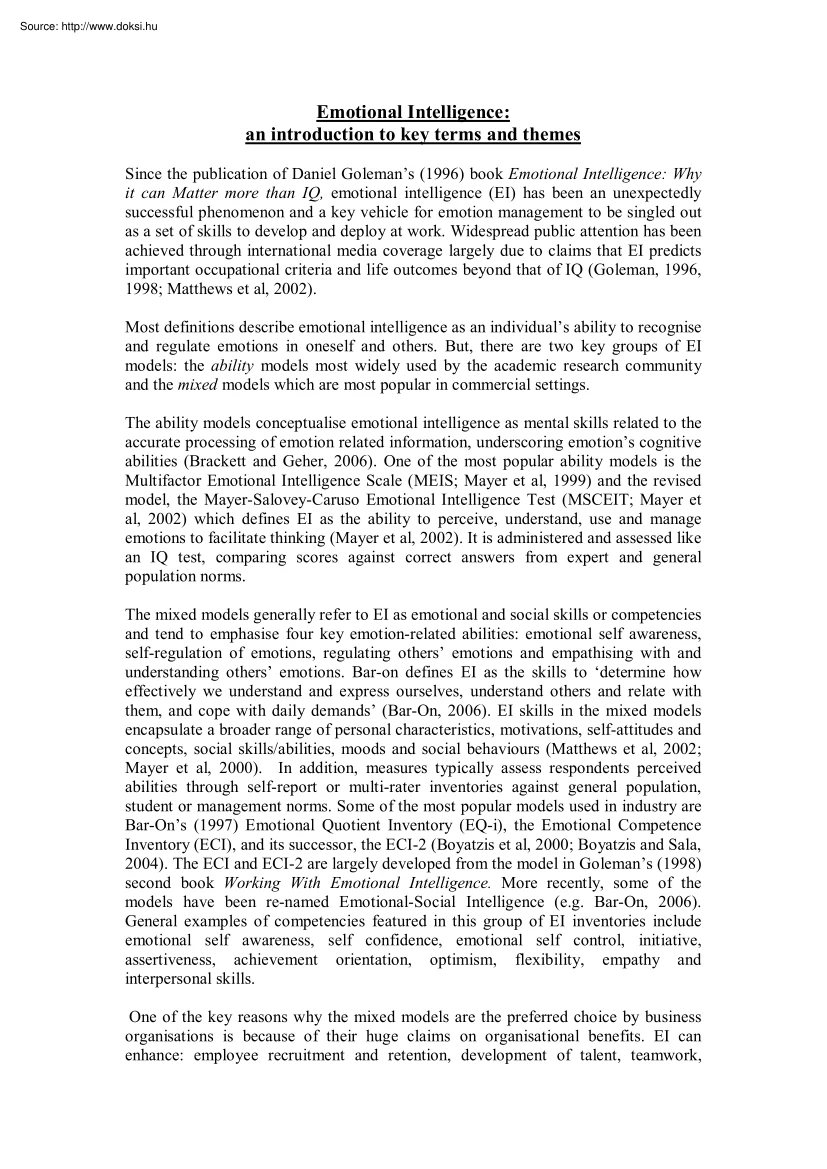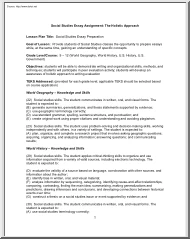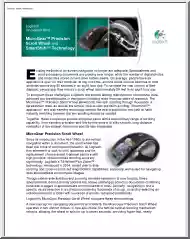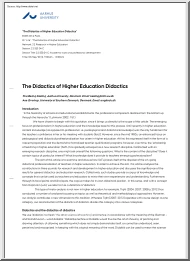A doksi online olvasásához kérlek jelentkezz be!

A doksi online olvasásához kérlek jelentkezz be!
Nincs még értékelés. Legyél Te az első!
Mit olvastak a többiek, ha ezzel végeztek?
Tartalmi kivonat
Emotional Intelligence: an introduction to key terms and themes Since the publication of Daniel Goleman’s (1996) book Emotional Intelligence: Why it can Matter more than IQ, emotional intelligence (EI) has been an unexpectedly successful phenomenon and a key vehicle for emotion management to be singled out as a set of skills to develop and deploy at work. Widespread public attention has been achieved through international media coverage largely due to claims that EI predicts important occupational criteria and life outcomes beyond that of IQ (Goleman, 1996, 1998; Matthews et al, 2002). Most definitions describe emotional intelligence as an individual’s ability to recognise and regulate emotions in oneself and others. But, there are two key groups of EI models: the ability models most widely used by the academic research community and the mixed models which are most popular in commercial settings. The ability models conceptualise emotional intelligence as mental skills related to
the accurate processing of emotion related information, underscoring emotion’s cognitive abilities (Brackett and Geher, 2006). One of the most popular ability models is the Multifactor Emotional Intelligence Scale (MEIS; Mayer et al, 1999) and the revised model, the MayerSaloveyCaruso Emotional Intelligence Test (MSCEIT; Mayer et al, 2002) which defines EI as the ability to perceive, understand, use and manage emotions to facilitate thinking (Mayer et al, 2002). It is administered and assessed like an IQ test, comparing scores against correct answers from expert and general population norms. The mixed models generally refer to EI as emotional and social skills or competencies and tend to emphasise four key emotionrelated abilities: emotional self awareness, selfregulation of emotions, regulating others’ emotions and empathising with and understanding others’ emotions. Baron defines EI as the skills to ‘determine how effectively we understand and express ourselves,
understand others and relate with them, and cope with daily demands’ (BarOn, 2006). EI skills in the mixed models encapsulate a broader range of personal characteristics, motivations, selfattitudes and concepts, social skills/abilities, moods and social behaviours (Matthews et al, 2002; Mayer et al, 2000). In addition, measures typically assess respondents perceived abilities through selfreport or multirater inventories against general population, student or management norms. Some of the most popular models used in industry are BarOn’s (1997) Emotional Quotient Inventory (EQi), the Emotional Competence Inventory (ECI), and its successor, the ECI2 (Boyatzis et al, 2000; Boyatzis and Sala, 2004). The ECI and ECI2 are largely developed from the model in Goleman’s (1998) second book Working With Emotional Intelligence. More recently, some of the models have been renamed EmotionalSocial Intelligence (e.g BarOn, 2006) General examples of competencies featured in
this group of EI inventories include emotional self awareness, self confidence, emotional self control, initiative, assertiveness, achievement orientation, optimism, flexibility, empathy and interpersonal skills. One of the key reasons why the mixed models are the preferred choice by business organisations is because of their huge claims on organisational benefits. EI can enhance: employee recruitment and retention, development of talent, teamwork, employee commitment and morale, productivity, efficiency, sales, revenues, quality of service and customer loyalty (Cherniss, 2001). The concept is reported to be the ‘essential but often neglected ingredient’ in nursing, law, medicine and engineering (Matthews et al, 2002: 4). Commerical models of EI have been associated with job satisfaction, job attitudes, creativity, innovation and performance in a range of occupations (e.g Boyatzis and Sala, 2004; Cooper and Sawaf, 1997; Day and Kelloway, 2004). Emotional intelligence is also
strongly linked to outstanding leadership and organisational values in both the mixed and ability models (Caruso, Mayer and Salovey, 2002; Goleman, 1996; 1998; Goleman et al, 2002; Boyatzis and Sala, 2004). EI is made further attractive to individuals because of a plethora of studies which highlight the personal benefits in relation to coping with daily demands, psychological health and general wellbeing (BarOn, 2004). EI is also attractive because it extends to the workplace, the notion of personal development and growth (Goleman, 1996; Fitness, 2006), currently popular in nonwork leisure pursuits, parenting and personal relationships. Overall, a key enticement for emotional intelligence’s successful transfer to businesses is that it is not wholly a genetic fixture of our selves but rather: ‘our competence in it can keep growing’ (Goleman, 1996: 7). Thus, EI can be learnt at work through brief coaching, training and development programmes. It’s straight forward
competency format, multirater assessment and fast administration makes it easily transferable for organisational use. Through the adoption of positive, common sense social skills language it resonates with executives, managers and staff alike, making it highly portable across many different roles. And its quantifiable nature expressed through statistical reliability, inventories and norm tables appeals to many organisations keen to nurture, measure and monitor emotions for performance gains. (766 words) ++++++++++++++++++++++++ Additional bit (if required): In addition, the attraction to EI is visibly inculcated into a number of important debates and preoccupations of contemporary business organisations. Emotional intelligence can be adopted as a response to external forces of increased business competition, customer service expectations and a harsh economic climate. For example, managers can flex new emotional skills to manage employee concerns during downsizing, merger and
other reorganisation programmes, to lay off workers, counsel remaining staff and manage their own feelings when imparting bad news (e.g Carr, 2001; Huy, 2002; Goleman, 1998) Links to customer service have been made in both types of EI models where aspects of emotional intelligence have been associated with generating an authentic quality customer service approach, developing long term customer relationships and performance related to handling angry customers (e.g Goleman, 1998; Daus, 2000). Equally, the concept offers effective ways to facilitate relationship building and collaborations within teams, complex organisational ‘networks’, and virtual or global project teams where EI skills help to build trust and rapport across technological divides. And the concept also promises help against workplace conflict and bullying through its corrective action on interpersonal skills. (184 words) References BarOn, R (1997) The Emotional Quotient Inventory (EQi): A test of
emotional intelligence. Technical Manual. Toronto: MultiHealth Systems BarOn, R. (2004) The BarOn Emotional Quotient Inventory (EQi): Rationale, description and summary of psychometric properties. In Geher, G (Ed) Measuring Emotional Intelligence: Common Ground and Controversy. Hauppauge, NY: Nova Science Publishing BarOn, R. (2006) ‘The BarOn Model of EmotionalSocial Intelligence (ESI)’, Psicothema, 18: 1325. Brackett, M.A and Geher, G (2006) Measuring emotional intelligence: paradigmatic diversity and common ground. In Ciarrochi, J, Forgas, JP and Mayer, JD (Eds) Emotional intelligence in Everyday life. NY: Psychology Press Boyatzis, R.E, Goleman, D and Rhee, KS (2000) Clustering competence in emotional intelligence: Insights from the Emotional Competence Inventory (ECI). In RBarOn and J.DA Parker (Eds) Handbook of Emotional Intelligence San Francisco, CA: Jossey Bass Boyatzis, R.E and Sala, F (2004) The Emotional Competency Inventory (ECI) In G Geher (Ed.)
Measuring Emotional Intelligence: Common Ground and Controversy Hauppauge, N.Y: Nova Science Publishing Carr, A. (2001) ‘Understanding emotion and emotionality in a process of change’, Journal of Organizational Change Management, 14(5): 421436. Caruso, D.R, Mayer, JD and Salovey, P (2002) Emotional intelligence and emotional leadership. In RE Riggio and SE Murphy (eds), Multiple Intelligences and Leadership Mahway, New Jersey: Erlbaum. Cherniss, C. (2001) Emotional intelligence and organizational effectiveness In Cherniss, C and Goleman, D. (eds) The Emotionally Intelligent Workplace San Francisco: JosseyBass Cooper, R.A and Sawaf, A (1997) Executive EQ London: Orion Business Daus, C.S (2002) Dissatisfaction as a function of emotional labour Paper presented at the 17th Annual Meeting of the Society of Industrial and Organizational Psychologists, Toronto, Canada, April. Day, A.L and Kelloway, EK(2004) ‘ Emotional intelligence in the workplace: rhetoric and reality’. In
Geher, G (Ed) Measuring Emotional Intelligence: Common Ground and Controversy. Hauppauge, NY: Nova Science Publishing Fitness, J. (2006) The emotionally intelligent marriage In Ciarrochi, J, ForgasJP and Mayer, J.D (eds) Emotional intelligence in everyday life NY: Psychology Press Goleman, D (1996) Emotional Intelligence. London: Bloomsbury Goleman, D (1998) Working with Emotional Intelligence. London: Bloomsbury Goleman, D., Boyatzis, R and McKee, A (2002) Primal Leadership: Realising the power of emotional intelligence. Boston: Harvard Business School Press Huy, Q. (1999) ‘Emotional capability, emotional intelligence and radical change’, Academy of Management Review, 24(2): 325345. Matthews, G, Zeidner, M and Roberts, R.D (2002) Emotional Intelligence: science and myth Cambridge, MA:MIT Press. Mayer, J.D, Caruso, D, and Salovey, P (1999), ‘Emotional intelligence meets traditional standards for an intelligence’, Intelligence, 27: 267298. Mayer, J.D, Salovey, P and
Caruso, DR (2000) Emotional intelligence as zeitgeist, as personality, and as a mental ability. In BarOn, R and Parker, J (Eds) The Handbook of Emotional Intelligence. San Francisco, California: Jossey Bass Mayer, J.D, Salovey, P and Caruso, D (2002) MayerSaloveyCaruso Emotional Intelligence Test (MSCEIT) technical manual. Toronto, Canada: MultiHealth Systems Key Readings BarOn, R. (2004) The BarOn Emotional Quotient Inventory (EQi): Rationale, description and summary of psychometric properties. In Geher, G (Ed) Measuring Emotional Intelligence: Common Ground and Controversy. Hauppauge, NY: Nova Science Publishing BarOn, R. and Parker, JDA (2000) (Eds), The Handbook of Emotional Intelligence San Francisco, CA: Jossey Bass Boyatzis, R.E and Sala, F (2004) The Emotional Competency Inventory (ECI) In G Geher (Ed.) Measuring Emotional Intelligence: Common Ground and Controversy Hauppauge, N.Y: Nova Science Publishing Cherniss, C. and Goleman, D (2001) (ed) The Emotionally
Intelligent Workplace San Francisco: JosseyBass Ciarrochi, J. Forgas, JP and Mayer, JD (eds) (2006) Emotional Intelligence in Everyday Life. New York: Psychology Press Goleman, D (1996) Emotional Intelligence. London: Bloomsbury Goleman, D (1998) Working with Emotional Intelligence. London: Bloomsbury Matthews, G, Zeidner, M. and Roberts, RD (2002) Emotional Intelligence: Science and Myth. Cambridge, MA:MIT Press Salovey, P., Brackett, MA and Mayer, JD (2004) (eds) Key Readings on the Mayer and Salovey Model. New York: National Professional Resources
the accurate processing of emotion related information, underscoring emotion’s cognitive abilities (Brackett and Geher, 2006). One of the most popular ability models is the Multifactor Emotional Intelligence Scale (MEIS; Mayer et al, 1999) and the revised model, the MayerSaloveyCaruso Emotional Intelligence Test (MSCEIT; Mayer et al, 2002) which defines EI as the ability to perceive, understand, use and manage emotions to facilitate thinking (Mayer et al, 2002). It is administered and assessed like an IQ test, comparing scores against correct answers from expert and general population norms. The mixed models generally refer to EI as emotional and social skills or competencies and tend to emphasise four key emotionrelated abilities: emotional self awareness, selfregulation of emotions, regulating others’ emotions and empathising with and understanding others’ emotions. Baron defines EI as the skills to ‘determine how effectively we understand and express ourselves,
understand others and relate with them, and cope with daily demands’ (BarOn, 2006). EI skills in the mixed models encapsulate a broader range of personal characteristics, motivations, selfattitudes and concepts, social skills/abilities, moods and social behaviours (Matthews et al, 2002; Mayer et al, 2000). In addition, measures typically assess respondents perceived abilities through selfreport or multirater inventories against general population, student or management norms. Some of the most popular models used in industry are BarOn’s (1997) Emotional Quotient Inventory (EQi), the Emotional Competence Inventory (ECI), and its successor, the ECI2 (Boyatzis et al, 2000; Boyatzis and Sala, 2004). The ECI and ECI2 are largely developed from the model in Goleman’s (1998) second book Working With Emotional Intelligence. More recently, some of the models have been renamed EmotionalSocial Intelligence (e.g BarOn, 2006) General examples of competencies featured in
this group of EI inventories include emotional self awareness, self confidence, emotional self control, initiative, assertiveness, achievement orientation, optimism, flexibility, empathy and interpersonal skills. One of the key reasons why the mixed models are the preferred choice by business organisations is because of their huge claims on organisational benefits. EI can enhance: employee recruitment and retention, development of talent, teamwork, employee commitment and morale, productivity, efficiency, sales, revenues, quality of service and customer loyalty (Cherniss, 2001). The concept is reported to be the ‘essential but often neglected ingredient’ in nursing, law, medicine and engineering (Matthews et al, 2002: 4). Commerical models of EI have been associated with job satisfaction, job attitudes, creativity, innovation and performance in a range of occupations (e.g Boyatzis and Sala, 2004; Cooper and Sawaf, 1997; Day and Kelloway, 2004). Emotional intelligence is also
strongly linked to outstanding leadership and organisational values in both the mixed and ability models (Caruso, Mayer and Salovey, 2002; Goleman, 1996; 1998; Goleman et al, 2002; Boyatzis and Sala, 2004). EI is made further attractive to individuals because of a plethora of studies which highlight the personal benefits in relation to coping with daily demands, psychological health and general wellbeing (BarOn, 2004). EI is also attractive because it extends to the workplace, the notion of personal development and growth (Goleman, 1996; Fitness, 2006), currently popular in nonwork leisure pursuits, parenting and personal relationships. Overall, a key enticement for emotional intelligence’s successful transfer to businesses is that it is not wholly a genetic fixture of our selves but rather: ‘our competence in it can keep growing’ (Goleman, 1996: 7). Thus, EI can be learnt at work through brief coaching, training and development programmes. It’s straight forward
competency format, multirater assessment and fast administration makes it easily transferable for organisational use. Through the adoption of positive, common sense social skills language it resonates with executives, managers and staff alike, making it highly portable across many different roles. And its quantifiable nature expressed through statistical reliability, inventories and norm tables appeals to many organisations keen to nurture, measure and monitor emotions for performance gains. (766 words) ++++++++++++++++++++++++ Additional bit (if required): In addition, the attraction to EI is visibly inculcated into a number of important debates and preoccupations of contemporary business organisations. Emotional intelligence can be adopted as a response to external forces of increased business competition, customer service expectations and a harsh economic climate. For example, managers can flex new emotional skills to manage employee concerns during downsizing, merger and
other reorganisation programmes, to lay off workers, counsel remaining staff and manage their own feelings when imparting bad news (e.g Carr, 2001; Huy, 2002; Goleman, 1998) Links to customer service have been made in both types of EI models where aspects of emotional intelligence have been associated with generating an authentic quality customer service approach, developing long term customer relationships and performance related to handling angry customers (e.g Goleman, 1998; Daus, 2000). Equally, the concept offers effective ways to facilitate relationship building and collaborations within teams, complex organisational ‘networks’, and virtual or global project teams where EI skills help to build trust and rapport across technological divides. And the concept also promises help against workplace conflict and bullying through its corrective action on interpersonal skills. (184 words) References BarOn, R (1997) The Emotional Quotient Inventory (EQi): A test of
emotional intelligence. Technical Manual. Toronto: MultiHealth Systems BarOn, R. (2004) The BarOn Emotional Quotient Inventory (EQi): Rationale, description and summary of psychometric properties. In Geher, G (Ed) Measuring Emotional Intelligence: Common Ground and Controversy. Hauppauge, NY: Nova Science Publishing BarOn, R. (2006) ‘The BarOn Model of EmotionalSocial Intelligence (ESI)’, Psicothema, 18: 1325. Brackett, M.A and Geher, G (2006) Measuring emotional intelligence: paradigmatic diversity and common ground. In Ciarrochi, J, Forgas, JP and Mayer, JD (Eds) Emotional intelligence in Everyday life. NY: Psychology Press Boyatzis, R.E, Goleman, D and Rhee, KS (2000) Clustering competence in emotional intelligence: Insights from the Emotional Competence Inventory (ECI). In RBarOn and J.DA Parker (Eds) Handbook of Emotional Intelligence San Francisco, CA: Jossey Bass Boyatzis, R.E and Sala, F (2004) The Emotional Competency Inventory (ECI) In G Geher (Ed.)
Measuring Emotional Intelligence: Common Ground and Controversy Hauppauge, N.Y: Nova Science Publishing Carr, A. (2001) ‘Understanding emotion and emotionality in a process of change’, Journal of Organizational Change Management, 14(5): 421436. Caruso, D.R, Mayer, JD and Salovey, P (2002) Emotional intelligence and emotional leadership. In RE Riggio and SE Murphy (eds), Multiple Intelligences and Leadership Mahway, New Jersey: Erlbaum. Cherniss, C. (2001) Emotional intelligence and organizational effectiveness In Cherniss, C and Goleman, D. (eds) The Emotionally Intelligent Workplace San Francisco: JosseyBass Cooper, R.A and Sawaf, A (1997) Executive EQ London: Orion Business Daus, C.S (2002) Dissatisfaction as a function of emotional labour Paper presented at the 17th Annual Meeting of the Society of Industrial and Organizational Psychologists, Toronto, Canada, April. Day, A.L and Kelloway, EK(2004) ‘ Emotional intelligence in the workplace: rhetoric and reality’. In
Geher, G (Ed) Measuring Emotional Intelligence: Common Ground and Controversy. Hauppauge, NY: Nova Science Publishing Fitness, J. (2006) The emotionally intelligent marriage In Ciarrochi, J, ForgasJP and Mayer, J.D (eds) Emotional intelligence in everyday life NY: Psychology Press Goleman, D (1996) Emotional Intelligence. London: Bloomsbury Goleman, D (1998) Working with Emotional Intelligence. London: Bloomsbury Goleman, D., Boyatzis, R and McKee, A (2002) Primal Leadership: Realising the power of emotional intelligence. Boston: Harvard Business School Press Huy, Q. (1999) ‘Emotional capability, emotional intelligence and radical change’, Academy of Management Review, 24(2): 325345. Matthews, G, Zeidner, M and Roberts, R.D (2002) Emotional Intelligence: science and myth Cambridge, MA:MIT Press. Mayer, J.D, Caruso, D, and Salovey, P (1999), ‘Emotional intelligence meets traditional standards for an intelligence’, Intelligence, 27: 267298. Mayer, J.D, Salovey, P and
Caruso, DR (2000) Emotional intelligence as zeitgeist, as personality, and as a mental ability. In BarOn, R and Parker, J (Eds) The Handbook of Emotional Intelligence. San Francisco, California: Jossey Bass Mayer, J.D, Salovey, P and Caruso, D (2002) MayerSaloveyCaruso Emotional Intelligence Test (MSCEIT) technical manual. Toronto, Canada: MultiHealth Systems Key Readings BarOn, R. (2004) The BarOn Emotional Quotient Inventory (EQi): Rationale, description and summary of psychometric properties. In Geher, G (Ed) Measuring Emotional Intelligence: Common Ground and Controversy. Hauppauge, NY: Nova Science Publishing BarOn, R. and Parker, JDA (2000) (Eds), The Handbook of Emotional Intelligence San Francisco, CA: Jossey Bass Boyatzis, R.E and Sala, F (2004) The Emotional Competency Inventory (ECI) In G Geher (Ed.) Measuring Emotional Intelligence: Common Ground and Controversy Hauppauge, N.Y: Nova Science Publishing Cherniss, C. and Goleman, D (2001) (ed) The Emotionally
Intelligent Workplace San Francisco: JosseyBass Ciarrochi, J. Forgas, JP and Mayer, JD (eds) (2006) Emotional Intelligence in Everyday Life. New York: Psychology Press Goleman, D (1996) Emotional Intelligence. London: Bloomsbury Goleman, D (1998) Working with Emotional Intelligence. London: Bloomsbury Matthews, G, Zeidner, M. and Roberts, RD (2002) Emotional Intelligence: Science and Myth. Cambridge, MA:MIT Press Salovey, P., Brackett, MA and Mayer, JD (2004) (eds) Key Readings on the Mayer and Salovey Model. New York: National Professional Resources



